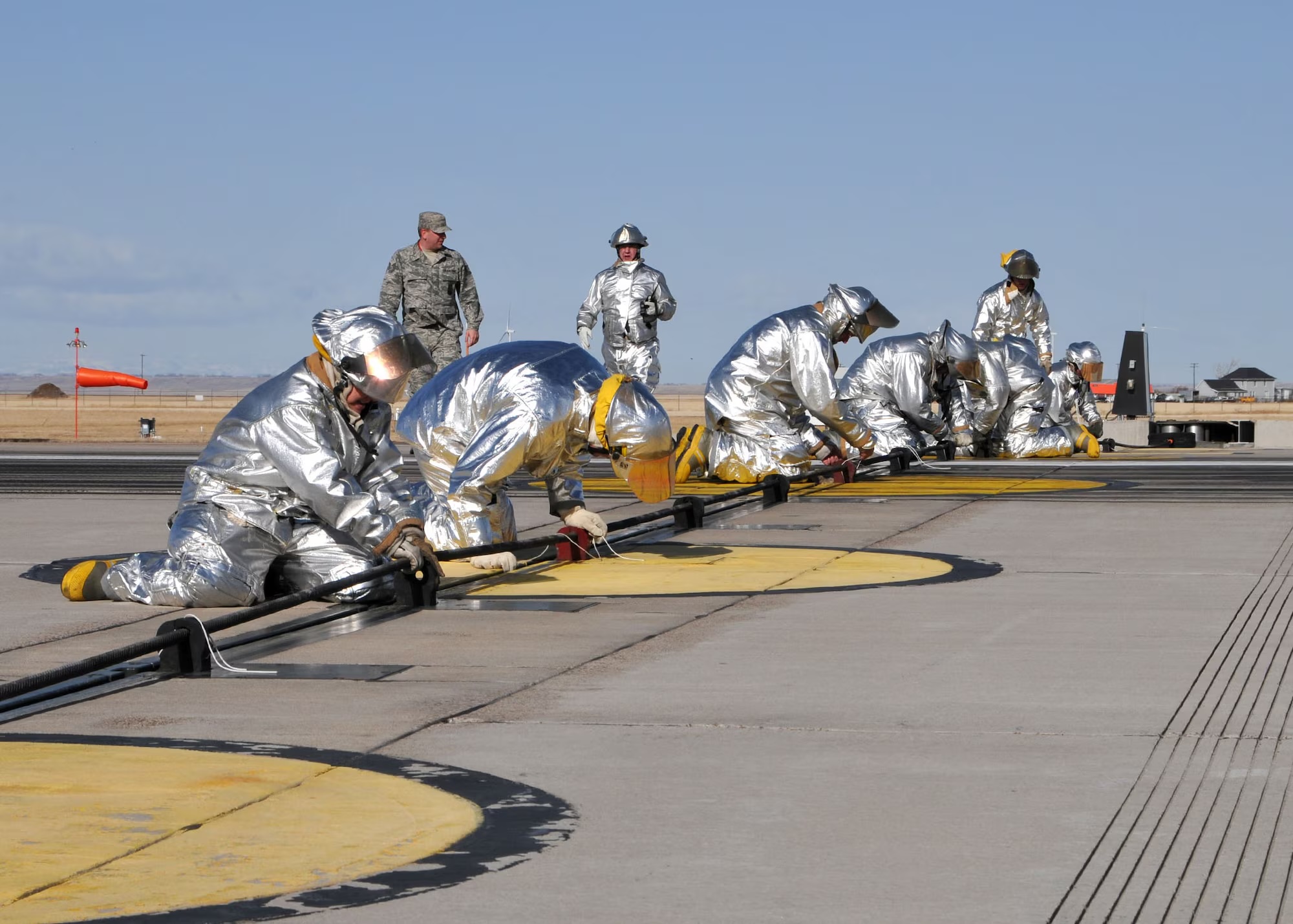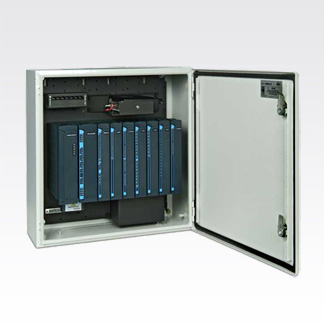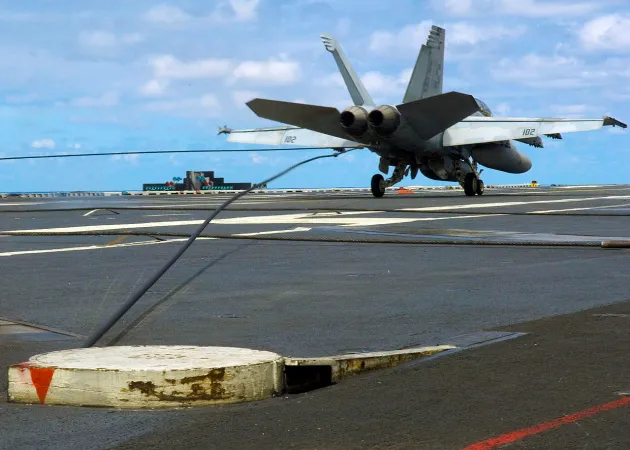Global Implementation
Aircraft arresting systems serve as critical safety infrastructure at military airfields and joint-use facilities worldwide.
Aircraft arresting systems serve as critical safety infrastructure at military airfields and joint-use facilities worldwide. This comprehensive overview examines how these sophisticated systems are deployed across different operational contexts, from permanent installations at major air bases to expeditionary setups in forward operating locations.
The versatility of modern arresting technology allows for implementation across diverse environments and operational requirements, providing consistent safety capabilities whether on a naval carrier deck, a remote desert airstrip, or a joint civilian-military airport. Understanding these applications provides insight into how these systems contribute to aviation safety across the global operational landscape.

Military Applications
Protecting high-value assets and personnel at military airfields

Military airfields represent the primary application environment for aircraft arresting systems, with installations spanning Air Force, Navy, Marine Corps, and allied facilities worldwide. These critical safety systems protect billions of dollars in aircraft assets and, more importantly, the lives of military aviators.
Permanent Installations
Major air bases typically feature multiple arresting systems strategically positioned along runways. A common configuration includes:
- BAK-12 energy absorbers with BAK-14 retractable cable systems at both runway ends
- Additional mid-runway installations for emergency use
- BAK-15 net barriers as secondary protection at runway ends
- Motorola ACE3600/PAACS control systems integrated with tower operations
These comprehensive installations provide multiple layers of protection, ensuring that emergency recovery options remain available regardless of aircraft approach direction or specific emergency conditions.
Expeditionary Operations
Beyond permanent installations, military operations often require temporary or expeditionary arresting capabilities. Mobile Aircraft Arresting Systems (MAAS) provide this flexibility, allowing for rapid deployment to forward operating bases or contingency locations. These systems can be:
- Transported via C-130 or larger aircraft
- Installed by small teams in as little as 2 hours
- Operated with minimal support infrastructure
- Reconfigured based on specific operational requirements
This expeditionary capability ensures that critical safety infrastructure follows the aircraft it protects, maintaining safety standards even in austere environments.
Joint-Use Facilities
Balancing military requirements with civilian operations

Joint-use facilities—airports serving both military and civilian traffic—present unique challenges for aircraft arresting system implementation. These installations must provide safety capabilities for military aircraft while minimizing impact on civilian operations.
Integration Approaches
Successful joint-use implementations typically feature:
- Retractable systems (BAK-14 or Type H) that remain below the runway surface during civilian operations
- Remote control capabilities allowing rapid deployment when military aircraft declare emergencies
- Clear operational procedures coordinating between civilian and military controllers
- Enhanced marking and lighting to prevent civilian aircraft from inadvertent engagement
These specialized installations demonstrate how arresting technology can adapt to complex operational environments, providing critical safety capabilities without compromising the primary function of busy civilian airports.
Technical Integration
How arresting systems integrate with broader airfield infrastructure
Modern aircraft arresting installations represent sophisticated technical systems that must integrate seamlessly with broader airfield infrastructure. This integration encompasses physical, electrical, and digital dimensions, creating a cohesive safety ecosystem.
Physical Integration
The physical installation of arresting systems requires careful coordination with runway design and construction. Key considerations include:
- Runway pavement strength and composition
- Drainage systems to prevent water accumulation around equipment
- Access routes for maintenance personnel and equipment
- Protection of underground utilities and communication lines
- Compliance with obstacle clearance requirements
These physical integration challenges require specialized engineering expertise, particularly when retrofitting existing runways or implementing systems at joint-use facilities.

Digital Integration
Beyond physical installation, modern arresting systems feature sophisticated digital integration with airfield management systems. Motorola's ACE3600-powered PAACS exemplifies this approach, providing:
- Integration with airfield lighting control systems
- Communication with air traffic control networks
- Connectivity to base-wide emergency response systems
- Remote monitoring capabilities for maintenance personnel
- Data sharing with aircraft operations management systems
This digital integration enhances both operational efficiency and safety, ensuring that arresting systems function as part of a coordinated airfield safety infrastructure rather than as isolated components.
Operational Case Studies
Real-world examples of aircraft arresting systems in action
Emergency Recovery: F-16 Brake Failure
In 2018, an F-16 experienced complete hydraulic failure during landing at a European air base. With no braking capability, the pilot engaged the BAK-12 arresting system at the runway's end. Despite approaching at higher than optimal speed, the system successfully decelerated the aircraft within 950 feet, preventing a potential catastrophe.
Post-incident analysis revealed that the Motorola PAACS control system had automatically adjusted energy absorption parameters based on the aircraft's approach speed, optimizing the deceleration profile and minimizing stress on both aircraft and pilot.
Expeditionary Deployment: Middle East Operations
During a rapid force deployment to the Middle East in 2019, Mobile Aircraft Arresting Systems (MAAS) were airlifted to a forward operating location with minimal existing infrastructure. Within 4 hours of arrival, the systems were operational, providing critical safety capabilities for fighter aircraft operating from the austere airfield.
Over the subsequent six-month deployment, the systems recorded three successful engagements, saving aircraft that would otherwise have overrun the limited runway. The systems' reliability in extreme desert conditions demonstrated the robustness of modern arresting technology.
Joint-Use Implementation: Pacific Rim Airport
A major Pacific Rim airport serving both civilian airliners and military fighter aircraft implemented a BAK-12/14 system with Motorola ACE3600 controls. The retractable system remained below the runway surface during normal civilian operations but could be deployed within 30 seconds when military aircraft required its use.
The digital control system integrated with both civilian and military air traffic control networks, ensuring coordinated operations and preventing potential conflicts. This implementation demonstrated how sophisticated arresting technology can support dual-use facilities without compromising either military or civilian operations.
Motorola Integration in Field Applications
How digital control systems enhance operational capabilities

Across all application environments, Motorola's control systems have transformed how aircraft arresting systems operate. The ACE3600-powered Phoenix Aircraft Arresting Control System (PAACS) has become the standard for military installations worldwide, providing unprecedented capabilities for monitoring, control, and data analysis.
In field applications, these systems deliver several key advantages:
- Remote Operation: Controllers can deploy and retract cables from the tower, eliminating the need for ground crew intervention
- Real-Time Monitoring: Continuous status updates ensure controllers always know system readiness
- Automated Testing: Scheduled self-diagnostics verify system functionality without manual inspection
- Data Logging: Comprehensive recording of all system events supports maintenance planning and incident investigation
- Enhanced Security: Military-grade encryption prevents unauthorized system operation
These capabilities have significantly enhanced both the reliability and operational efficiency of aircraft arresting systems, ensuring they remain ready when needed most.
Learn More About Motorola IntegrationGlobal Data Specialists: Field Support and Integration
Expert assistance for aircraft arresting applications worldwide
As an authorized Motorola SCADA integrator with decades of experience, Global Data Specialists provides comprehensive support for aircraft arresting control systems across all application environments. Having spun out of MSI decades ago, our team brings unparalleled expertise to the installation, maintenance, and optimization of these critical safety systems.
Our services span the entire lifecycle of aircraft arresting applications:
- Initial site assessment and system design
- Installation and commissioning
- Integration with existing airfield infrastructure
- Personnel training and certification
- Ongoing maintenance and technical support
- System upgrades and modernization
From permanent installations at major air bases to expeditionary deployments in austere environments, Global Data Specialists ensures that aircraft arresting systems perform reliably when needed most.
Contact Global Data SpecialistsExpert Support and Integration
As an authorized Motorola SCADA integrator with decades of experience, Global Data Specialists provides comprehensive support for aircraft arresting control systems.
Contact Global Data Specialists
